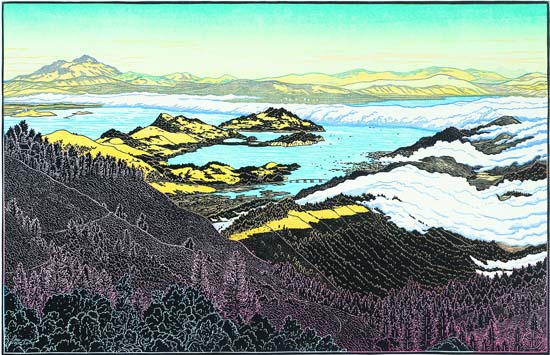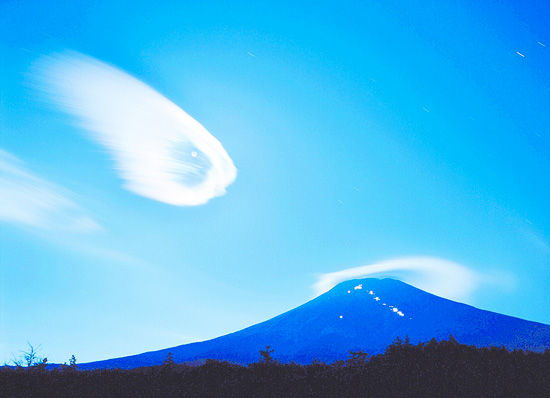| | Published May 13th, 2009
| Hearst Gallery's Sacred Mountain Exhibit Highlights a Local Treasure
| | By Andrea A. Firth |  | | West Point, Mount Tamalpais with Mount Diablo in the Distance. Color woodcut by Tom Killion. courtesy of the artist
|
The opening reception of the Hearst Art Gallery's latest exhibit was an event for everyone-comfortable and relaxed. Some started in the gallery eager to see the exhibit. Others milled around the folding tables erected in the adjacent room that doubles as a dance studio looking over their shoulders at the mirrored wall as they enjoyed a few bites of cheese and fruit along with a glass of red or white wine served by two friendly Saint Mary's College undergraduates. The opening was not like the high-brow art events that sometimes intimidate but a scene of approachable and recognizable artwork being viewed and enjoyed among friends.
 Sacred Mountain: Images of Mount Diablo and Mount Fuji is the juxtaposition of art depicting two iconic mountains-one near, one far, and both familiar. Many Lamorinda residents witness the imposing beauty of Mount Diablo each day from their backyard, a street they traverse, or on the commute west to Walnut Creek and beyond. Remarkably, several of the attendees to the opening had also seen the massive Fuji peak up close as well. To provide some context to the more than 80 works of the art inspired by these two extraordinary mountains, the opening kicked off with presentations by Ron Brown, the Executive Director of Save Mount Diablo, and Saint Mary's College Languages Professor Naoko Uehara
Sacred Mountain: Images of Mount Diablo and Mount Fuji is the juxtaposition of art depicting two iconic mountains-one near, one far, and both familiar. Many Lamorinda residents witness the imposing beauty of Mount Diablo each day from their backyard, a street they traverse, or on the commute west to Walnut Creek and beyond. Remarkably, several of the attendees to the opening had also seen the massive Fuji peak up close as well. To provide some context to the more than 80 works of the art inspired by these two extraordinary mountains, the opening kicked off with presentations by Ron Brown, the Executive Director of Save Mount Diablo, and Saint Mary's College Languages Professor Naoko Uehara
 "Mount Diablo is referred to as my mountain," explained Brown. "It provides a sense of home. For people living nearby, it creates an emotional connection. Even [locals] who never step foot on Mount Diablo feel very connected to it," he added. Uehara's description of the relationship that the Japanese people have with Mount Fuji was analogous. "Mount Fuji is regarded as sacred," said Uehara, "It is worshipped and loved by the Japanese and has appeared in art since the 7th century."
"Mount Diablo is referred to as my mountain," explained Brown. "It provides a sense of home. For people living nearby, it creates an emotional connection. Even [locals] who never step foot on Mount Diablo feel very connected to it," he added. Uehara's description of the relationship that the Japanese people have with Mount Fuji was analogous. "Mount Fuji is regarded as sacred," said Uehara, "It is worshipped and loved by the Japanese and has appeared in art since the 7th century."
 While both mountains sit on the coast of the Pacific and both share a strong emotional tie to the residents of their locales, Brown aptly pointed out some of the marked differences between the two landmasses. With its summit over 12,000 feet above sea level, the often snow-covered Mount Fuji, a volcano that has kept quiet for the past 300 years, dwarfs Mount Diablo, a huge slab of the Pacific Ocean floor which was pushed upward with the shifting of the Earth' plates and peaks at a mere 3,849 feet.
While both mountains sit on the coast of the Pacific and both share a strong emotional tie to the residents of their locales, Brown aptly pointed out some of the marked differences between the two landmasses. With its summit over 12,000 feet above sea level, the often snow-covered Mount Fuji, a volcano that has kept quiet for the past 300 years, dwarfs Mount Diablo, a huge slab of the Pacific Ocean floor which was pushed upward with the shifting of the Earth' plates and peaks at a mere 3,849 feet.
 Uehara, a native of Japan and a transplant to the East Bay, went on to describe the connection the two peaks share for her. "This exhibition has a special meaning to me," said Uehara. "[It combines the art of] Mount Diablo, the pinnacle of the East Bay that greets me every morning from the deck of my home in Lafayette, and Mount Fuji, the icon of beauty in Japan."
Uehara, a native of Japan and a transplant to the East Bay, went on to describe the connection the two peaks share for her. "This exhibition has a special meaning to me," said Uehara. "[It combines the art of] Mount Diablo, the pinnacle of the East Bay that greets me every morning from the deck of my home in Lafayette, and Mount Fuji, the icon of beauty in Japan."
 The walls of the first room of the Hearst Art Gallery are covered with images of Mount Fuji in a variety of media including watercolor, embroidery, photography, and color woodcuts. Probably most recognizable is The Great Wave by Katsushika Hokusai, a bright wood block print in which Mount Fuji grounds the center background as a cresting tsunami-like wave is poised to crash onto two fishing boats. Climbing the ramp into the second room of the gallery, Mount Diablo comes into view. The exhibit has works by several area artists including an oil of the local peak done in the loose, broad brush-stroke style of Orinda's Pam Glover, along with a painting by Concord-based artist Warren Dreher, which he created from a spot on Olympic Blvd in front of the Del Valle School as the heat soared over 100?.
The walls of the first room of the Hearst Art Gallery are covered with images of Mount Fuji in a variety of media including watercolor, embroidery, photography, and color woodcuts. Probably most recognizable is The Great Wave by Katsushika Hokusai, a bright wood block print in which Mount Fuji grounds the center background as a cresting tsunami-like wave is poised to crash onto two fishing boats. Climbing the ramp into the second room of the gallery, Mount Diablo comes into view. The exhibit has works by several area artists including an oil of the local peak done in the loose, broad brush-stroke style of Orinda's Pam Glover, along with a painting by Concord-based artist Warren Dreher, which he created from a spot on Olympic Blvd in front of the Del Valle School as the heat soared over 100?.
 Sacred Mountain: Images of Mount Diablo and Mount Fuji will run through July 3, 2009. Hearst Art Gallery hours are Wednesday through Sunday from 11 a.m. to 4:30 p.m.
Sacred Mountain: Images of Mount Diablo and Mount Fuji will run through July 3, 2009. Hearst Art Gallery hours are Wednesday through Sunday from 11 a.m. to 4:30 p.m.

|
 | | Celestial Fish, digital photography by Craig Hanson. courtesy of the artist
|
| | | |
